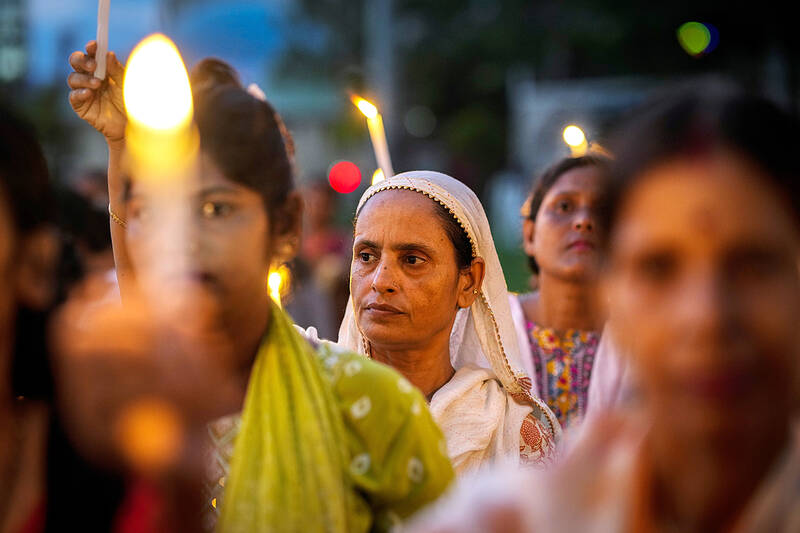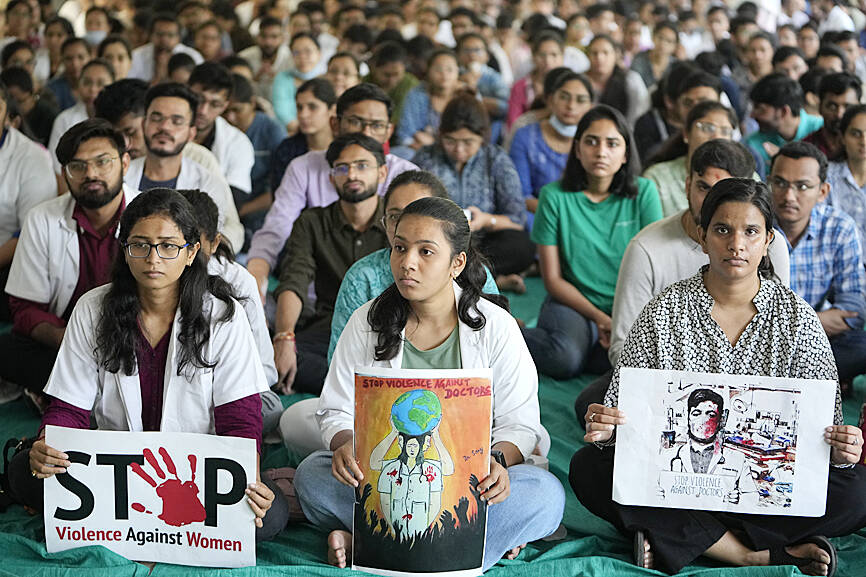Hospitals and clinics across India yesterday turned away patients except for emergency cases as medical professionals began a 24-hour shutdown in protest against the brutal rape and murder of a doctor in the eastern city of Kolkata.
More than 1 million doctors were expected to join the strike, paralyzing medical services across the world’s most populous nation.
Hospitals said faculty staff from medical colleges had been pressed into service for emergency cases.

Photo: AP
The strike, which began at 6am, cut off access to elective medical procedures and out-patient consultations, the Indian Medical Association said in a statement.
The discovery of the 31-year-old doctor’s bloodied body at a state-run hospital on Friday last week sparked furious protests in several cities across the country. Many have been led by doctors and other healthcare workers, but have also been joined by tens of thousands of ordinary Indians demanding action.
In Kolkata, thousands held a candle-lit vigil into the early hours of yesterday morning.

Photo: AP
“Hands that heal shouldn’t bleed,” read one handwritten sign held by a protester in the city.
“Enough is enough,” read another at a rally by doctors in the capital New Delhi.
The murdered doctor was found in the teaching hospital’s seminar hall, suggesting she had gone there for a rest during a 36-hour shift.
An autopsy confirmed sexual assault and, in a petition to the court, the victim’s parents said they suspected their daughter was gang-raped.
One man, who worked at the hospital helping people navigate busy queues, has been detained.
However, Kolkata’s police were accused by an angry public of mishandling the case and the city’s High Court transferred the investigation to the Indian Central Bureau of Investigation to “inspire public confidence.”
Those in government hospitals across several states on Monday halted elective services “indefinitely,” with multiple medical unions in government and private systems backing the strikes.
The Indian Medical Association (IMA) escalated protests yesterday morning with a 24-hour “nationwide withdrawal of services.”
“We ask for the understanding and support of the nation in this struggle for justice for its doctors and daughters,” IMA chief R.V. Asokan said in a statement ahead of the strike.
“The 36-hour duty shift that the victim was in and the lack of safe spaces to rest ... warrant a thorough overhaul of the working and living conditions of the resident doctors,” the IMA said in a statement.
Doctors are demanding the implementation of the Central Protection Act, a bill to protect healthcare workers from violence.
“There is a lack of proper infrastructure,” said 29-year-old Akanksha Tyagi, a resident at the Lady Hardinge Medical College in New Delhi who took part in one of the protests.
“After working for 24 to 36 hours at a stretch, there’s no proper place for us to rest,” she said.
Additional reporting by Reuters

‘UNUSUAL EVENT’: The Australian defense minister said that the Chinese navy task group was entitled to be where it was, but Australia would be watching it closely The Australian and New Zealand militaries were monitoring three Chinese warships moving unusually far south along Australia’s east coast on an unknown mission, officials said yesterday. The Australian government a week ago said that the warships had traveled through Southeast Asia and the Coral Sea, and were approaching northeast Australia. Australian Minister for Defence Richard Marles yesterday said that the Chinese ships — the Hengyang naval frigate, the Zunyi cruiser and the Weishanhu replenishment vessel — were “off the east coast of Australia.” Defense officials did not respond to a request for comment on a Financial Times report that the task group from

Asian perspectives of the US have shifted from a country once perceived as a force of “moral legitimacy” to something akin to “a landlord seeking rent,” Singaporean Minister for Defence Ng Eng Hen (黃永宏) said on the sidelines of an international security meeting. Ng said in a round-table discussion at the Munich Security Conference in Germany that assumptions undertaken in the years after the end of World War II have fundamentally changed. One example is that from the time of former US president John F. Kennedy’s inaugural address more than 60 years ago, the image of the US was of a country

DEFENSE UPHEAVAL: Trump was also to remove the first woman to lead a military service, as well as the judge advocates general for the army, navy and air force US President Donald Trump on Friday fired the chairman of the Joint Chiefs of Staff, Air Force General C.Q. Brown, and pushed out five other admirals and generals in an unprecedented shake-up of US military leadership. Trump wrote in a post on Truth Social that he would nominate former lieutenant general Dan “Razin” Caine to succeed Brown, breaking with tradition by pulling someone out of retirement for the first time to become the top military officer. The president would also replace the head of the US Navy, a position held by Admiral Lisa Franchetti, the first woman to lead a military service,

BLIND COST CUTTING: A DOGE push to lay off 2,000 energy department workers resulted in hundreds of staff at a nuclear security agency being fired — then ‘unfired’ US President Donald Trump’s administration has halted the firings of hundreds of federal employees who were tasked with working on the nation’s nuclear weapons programs, in an about-face that has left workers confused and experts cautioning that the Department of Government Efficiency’s (DOGE’s) blind cost cutting would put communities at risk. Three US officials who spoke to The Associated Press said up to 350 employees at the National Nuclear Security Administration (NNSA) were abruptly laid off late on Thursday, with some losing access to e-mail before they’d learned they were fired, only to try to enter their offices on Friday morning